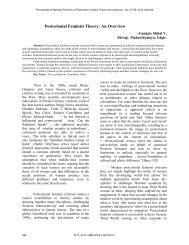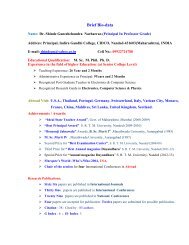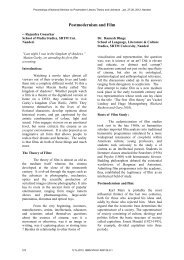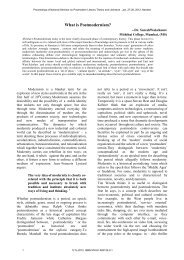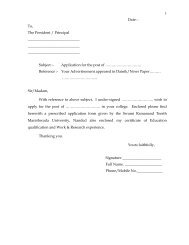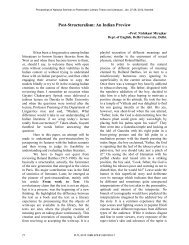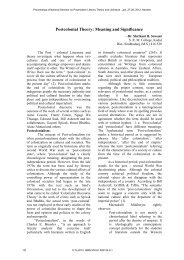Multiculturalism - Igcollege.org
Multiculturalism - Igcollege.org
Multiculturalism - Igcollege.org
You also want an ePaper? Increase the reach of your titles
YUMPU automatically turns print PDFs into web optimized ePapers that Google loves.
Proceedings of National Seminar on Postmodern Literary Theory and Literature , Jan. 27-28, 2012, NandedThe story has a sub-plot .The Muslim Nawab(Jamindar) and his forefather died due to curseof god, because they had adopted the Europeanhabits of bad company and drink. Howevervillagers are against both the British and MuslimRaj. The conversational pieces are veryinteresting to analyze in terms multiculturalaspect. The narrator of the story is Chajju(Hindu), who is the ring-leader of the ‘goondas’(caste) and has been allow to return offer somedays exile. This story is an excellent example formulticulturalism.The Villagers; ‘after all the Zamindar isin the position of a ma-bap, to us.’ tobatoba!’Chup Kar etc.(The Tractor and the corn goddess’.pp45)The use of these hybrid linguistic items servesthe purpose to insert a feel of culture into thetext. Mulk Raj Anand describes Hindu andMuslim culture and the use of the language formaintaining cultural flavor. The story opens witha description of features of the villagers and theZamindar. The actual incident takes place onemorning under the banyan tree just outside thebig home. The giant tractor is fetched aroundeleven o’clock from the Railways Station byComrade Abdul Hamid the Engineer (Muslim).Abdul Hamid has brought the monster enginenot across the main road, as the machinefurrowed the earth deeply. At this junctureChajju (Hindu) takes the lead in the crisis. Thefollowing linguistic exchange between theHindu peasants are not at all ready to admit theauthenticity of the development and newinventions, whereas the Muslim religion’ whichmeans they are ready to change themselves byidentifying the steps of the development theworld. It is noted that Hindu characters in thisstory wanted to remain on the same position andtherefore, they opposes the development of theMuslim. The above conversation is anamalgamation of two cultures and their speechhas indicated the same. Here, the utterance madeby the Villagers (Hindu) is nothing but themulticultural study at the lexical level takesplace in this story. The following of collectivismmake our doubt clear that religion, earth and oldtradition of Hindu.The Hindu Peasant; rape –mother,even as he sat smoking the hubblebubbleunder the banyan tree.The Phau said; that’s right, “I hear ittore up the earth as it came alone” TheSambhu Nath; The earth then deserted!The Dhunni Bhagat; that the corngoddess has been raped, then thisInstrument ought to be send back acrossthe sea t the perverts who have inventedit……The Tirath: ‘our religion hasbeen despoiled…’(The Tractor and the corn goddess’pp45)According the first component collectivism theinterlocutors are talking about the ‘Earth’ and‘religion’. They are stick to the conventionalphilosophy and not prepare to face the newchallenges in life. The threat is of destruction oftheir traditional routine of life. The speakers arefrom economically non-developed categories.Chajju, the leader of the farmers is really angryhe fears that the question of unemployment maystand up the village in the future. They think thatthe tractor will rape the earth and their cornGoddess will be destroyed and nothing willremain for them who have been nourished fornumberless of generation by the land. Thisrepresents or symbolizes the religion, andeconomical lower strata of society. ‘The Tractorand the Corn Goddess’ is a multidimensionalshort story which highlights many aspects orlayers of Indian society. Mulk Raj Anand hashighlighted the ever-burning issue in Indiabefore and after independence, namely that theIndians are followers of the traditional ways oflife. The villagers doubt the intention of theNawab, who has brought the tractor to thevillage as the specimen of new invention, ofwhich the villagers are totally in ignoranceutterance. Nawab tries to convince the villagersabout the tractor, saying that it is a newdevelopment and might bring much constructivechange in the villagers’ life. Thus, ‘The Tractorand Corn Goddess’ is a story depicting the496 PLTL-2012: ISBN 978-81-920120-0-1



